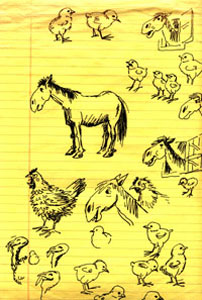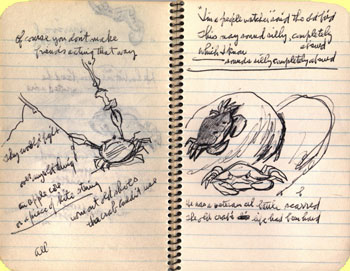“Having written and illustrated 28 books doesn't make me an authority on how to create a picture book. And I don’t have any secret formulas, or short cuts for doing one (no formula for originality). No right or wrong in creative work – no way to teach originality. My most recent efforts were just as frustrating as the early books, alas!! Experience - practice - doesn’t make the work easier, in fact it may be more difficult after so many books.
The more ideas one has used up, the less he has coming.” *** “I always begin my stories as experiments – on large yellow tablets – a mixture of writing and sketching. (day dreaming)” ***
“Sometimes I draw character first just to get acquainted; then decide what problem they might have.” *** “I am an author-illustrator of children’s books – and yet – I must confess I don’t do the books for the kids. When I’m working on a book I’m somewhere else – at the circus – or a rustic old farm – or deep in a forest – with no thought of who might read the book or what age group it would appeal to. I write them so I can illustrate them.” ***
“It could be that when I’m creating a book I take a nostalgia trip back to my boyhood years in Indiana. When I’m illustrating I can visualize the farms, fields, the forests, the old barns, the big top circuses, the great locomotives going full steam. A better time for artists – It was far more visually exciting.”

Above, a page from a yellow legal tablet. Sketches for Cock-a-doodle Dudley
*** “When I was a kid I thought sure that I would be content if I could find a reason to draw pictures the rest of my life. I never suspected that drawing pictures for someone else (Greeting card Co., Disney’s) would be frustrating and far from being creative.” ***
“Being both author and illustrator gives me the choice of subject matter. If I want to draw an elephant, I write about one, if I want to draw lions tigers, bears, dragons, trains – I write about them. ***“When I plan a story I make lots of sketches of the characters. After I draw them I know them better, then I find it easier to write about them.” *** “If I go for a week or two without doing a drawing – I more than make up for it, by doing 50 or 100 drawings on some days. Averaged out over the years I’ve probably done at least 2 or 3 drawings per day (more).” ***
“I bought a number of books, instructional books on how to write stories, but couldn’t read them. So I had to learn by doing, and during those Disney years I wrote a number of magazine pieces, Christmas story for McCalls, and finally screen scenarios for Disney’s animated features (but always illustrating).” ***
“Words describe the thinking of the characters – and not deal with landscapes, or mood of the weather – color of things – anymore than necessary. Balance between text and pictures.” *** “No way to keep track of time – false starts – rewrites. Spend half the time on stories that I may never complete.” *** “I do recall how I got the ideas for some of my books. Many of them are a result of doodling.”
(See Book List to
learn the origins of many of his stories.)

*** “I don’t like to get preachy, but when it works well with the story I’ll bring out a point, and at the same time, I hope to make it entertaining, and fun to read.” *** “Above all, a story book should stimulate an interest in reading. If there is a point made – teaches a lesson or a moral – so much the better.”